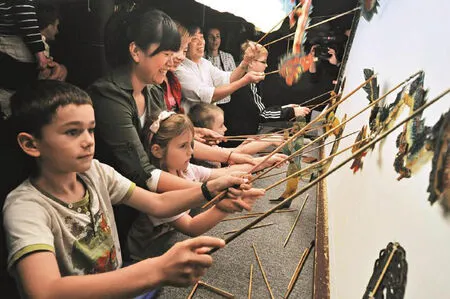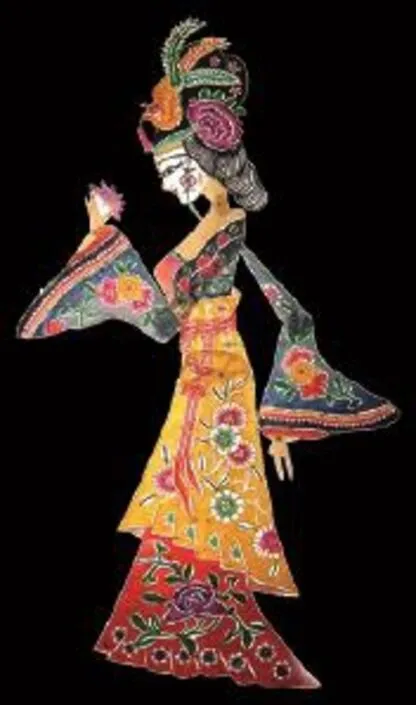Shadow Puppet Play
By GU HE
Shadow Puppet Play
By GU HE

Foreign children try their hands as shadow puppeteers.
SHADOW puppetry, also known as “shadow play,” is a traditional form of storytelling through the medium of flat articulated, elaborately engraved figures. Manipulating them with silken strings and bamboo rods between a source of light and a translucent screen, puppeteers make the characters dance and sing to the accompaniment of percussion and orchestral instruments.
Puppets are usually made from cardboard, or leather fashioned from cattle, donkey, sheep, or camel hide. After being cured, washed, dried and ironed, there are 10 more processes, including design, the sketching of an outline, engraving, and coloring. The puppet head, limbs and torso are separately engraved and strung loosely into a flexible, manipulable whole.
The design and decoration of puppets denote where they are made. Those of Shaanxi and Gansu provinces are distinct for their prominent foreheads. In Inner Mongolia and Northeast China, they have freehand-hollowed faces.Those from southern China, for example Zhejiang Province, are brightly painted rather than ornately engraved.
Performance styles also vary from region to region. Generally speaking, puppeteers appear omniscient in being able to simultaneously manipulate the silk strings to which the puppets are attached while beating a foot drum or gong in time to their movements, all the while narrating the story and singing ballads.
The performance screen is generally a one-square-meter sheet of white gauze, behind which the puppeteer skillfully manipulates the silhouetted marionette, making it appear incredibly human.
Puppet shadow play often features in contemporary films and television dramas. For instance in the TV series Palace of Desire (Daminggong Ci), Emperor Gaozong of the Tang Dynasty (618-907) and his paramour Lady Helan are depicted as passionate shadow play aficionados, and in the movie To Live, shadow play links the story’s different epochs. In 2011, Chinese shadow puppetry was inscribed on the UNESCO representative list of the Intangible Cultural Heritage of Humanity.

The flat articulated figures are engraved on animal hides or paper.
Scholars hold that Chinese shadow puppetry originated in the Western Han Dynasty (206 BC - AD 25). When the favorite concubine of Emperor Wudi (156 - 87 BC) died of illness, the ruler was so devastated that a necromancer devised the idea of a back-lit puppet show behind a curtain. The star marionette was a likeness of the emperor’s beloved, which both consoled and delighted him.
Shadow puppet stage drama dates back to the Northern Song Dynasty (960-1127) when its capital Bianjing (today’s Kaifeng of Henan Province) was in the first flush of prosperity. When Jin (1115-1234) troops captured Bianjing, some puppeteers were hijacked farther north, and later escaped and followed the Southern Song Dynasty (1127-1279) government to the south of the Yangtze River. Shadow puppet plays thereafter flourished in the vast areas either side of the river.
In the Yuan Dynasty (1279-1368), Chinese shadow play was introduced to Persia and other West Asian countries, and is still popular today in Turkey. The Ming and Qing dynasties (1368-1911) were the golden age of shadow play. During the reign of Qing Emperor Qianlong (1736-1796), a French missionary took shadow play to France. There it became immensely popular. Known as“Chinese Shadow Light,” from it evolved the distinctively “French Shadow Light.”In 1781, German literary giant Goethe celebrated his birthday with a shadow play performance, delighting all his guests. In the late Qing Dynasty, however, shadow play in public areas was forbidden for fear of mob disturbances. The performance art thus waned and almost disappeared.
As the world’s earliest screened performance art, shadow puppetry is widely regarded as the forerunner of movies. But with the boom of new media, its audience is considerably depleted. Challenges to keeping it alive include the difficulty of preserving puppet-making techniques, the intricate and consummate skills required of puppeteers, and making the content relevant to contemporary issues.
Fortunately, some innovators have thought of ways of combining puppetry with animations. But in the new era, integrating ancient puppet shadow play into new models and preserving the heritage of this venerable performance art for future generations, even with the help of the Internet and high technology, is no easy task. There is a long road ahead to achieving it
(Selected from Monthly Digest by Zhonghua Book Company)

